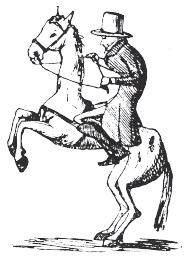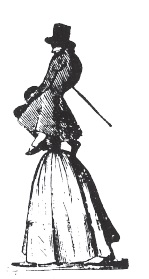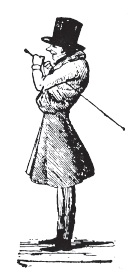Kierkegaard (17 page)
Authors: Stephen Backhouse

Cartoon from the
Corsair
. The picture evokes the image of a real event in Søren's life when he once attempted to ride a horse.
The crude satire eked along until the July 17, 1846, edition, but by then it was clear the
Corsair
's crew had run out of cannonballs. Goldschmidt and Møller had a falling out over the production of the paper. Møller was excluded from the
Corsair
, and Goldschmidt was growing weary of the whole affair
.
A few months previous, Aron had chanced upon Søren on the street. They did not speak. There was nothing more that could be said. Kierkegaard, Aron remembers, “
walked past me
with an intense and extremely embittered look.” Aron felt “accused and oppressed: the
Corsair
had triumphed in the battle, yet I myself had acquired a false sense of being number one.” Before he got home, Aron made up his mind to give up the
Corsair
for good. Goldschmidt was eventually able to sell off the paper. He went to live abroad in Germany and Italy before returning to Copenhagen as the (publicly named) founder of the respectable political journal
North and South
.
For his part, Møller continued to write sarcastic reviews of Kierkegaard's works, as well as minor works of poetry of his own. He never received the recognition he thought was owed to him. However dubious and unrealistic Møller's aspirations actually were to academic
respectability, he blamed Kierkegaard for the slight. Møller too left Denmark in 1847. Unlike Aron, he never returned home, dying in obscurity and poverty in 1865.
The effects of the feud and mocking campaign are more easily stated than understood. For the principal players, the affair was life-changing. For those not directly involved, it can seem but a trifle. This is not only true for modern observers. Even some of Søren's contemporaries found it difficult to empathise. It was Hans Brøchner's opinion that Søren exaggerated the effects of the
Corsair
: “
He [Søren] could reflect
on a trifle until it assumed world-historical significance, as it were.” However, in his memoirs written thirty years after the fact, Goldschmidt is keen to remind people of the particular historical sweet spot in which the affair of the
Corsair
occurred. “
Accustomed as we are now
[1877] to vehement and violent newspaper articles, one will have difficulty in understanding how it could sound in that anxious, quiet time [1846].” Søren's nephew Troels Frederik agrees, “
In our time
it is hard to imagine the chilling vulnerability that could be the lot of a victim of such attacks in those days.” The public and popular worlds of Copenhagen in 1846 were on the cusp of change. The moral right of pseudonymity was still largely respected and acted as a bulwark against personal attacks, which wider society frowned on in any case. Furthermore, the political revolutions sweeping Europe were still two years away, with all the ferocious character assassinations and “take no prisoners” rhetoric that come with all culture wars. In Denmark in the '40s, the convention of naming and shaming in print (a matter of course in the modern age) was still relatively new and shocking.

Cartoon from the
Corsair
. A famous author rises to prominence by riding on the back of an innocent young girl.
The active members of Denmark's literary Golden Age were used to lobbing witty and erudite salvos at each other from behind the comfort of their own pseudonyms. The tone and content of the
Corsair
gave license to a level of mockery Kierkegaard did not expect. His walks down the street would be followed by jeering catcalls of “Søren! Søren!” or “Either Or!” from members of the public. “
Every kitchen boy
feels justified in almost insulting me in accordance with the
Corsair
's orders,” he vented in his journal, “young students titter and grin and are happy to see a prominent person trampled on. . . . The slightest thing I do, if it is merely to pay a visit . . . if the
Corsair
finds out, it is printed and read by everybody, the man I visit is embarrassed, gets almost angry with me, for which he cannot be blamed.” On his city walks, Søren encountered groups of people who either would sheepishly stop talking when he approached or call out names as he passed. Matrons with their charges in the park allowed the children to run up to Søren, one after the other, so that they could ask inane questions and run giggling back to the group. Søren would sit in his pew at church, only to overhear his neighbours talking in a loud voice about his trousers.

Cartoon from the
Corsair
. Søren's curved spine is mocked here.
The trousers. Always the trousers. Søren's physicality became a focal point for attention, and his legs especially a matter for scrutiny. This public obsession with how well his ungainly body was clothed was not a figment of Søren's imagination.
“Once,”
Troels Frederik recalls of his uncle, “I was walking behind him and wanted to run up to him to say hello. But just at that moment I heard some passer-by say something mocking about him and saw a couple of people on the other side of the street stop, turn around to look at him and laugh. His one trouser
leg really was shorter than the other . . . he was odd-looking. I instinctively stopped, was embarrassed, and suddenly remembered that I had to go down another street.” The philosopher George Brandes recalled how when he was growing up, if he tried to leave the house with his socks showing, his Nanny would admonish him,
“Don't be such a Søren Kierkegaard!”
Things got so bad that Kierkegaard's tailor hinted that if Søren were to find another garment maker, it certainly would not hurt business. The taunting, grins, gapes, and social embarrassment made Søren's beloved “people baths” untenable. Formerly he had prided himself on his ability to converse with people of all stations. Now “it is the rabble, the utterly brutish humanity, the rowdies, silly women, schoolchildren, and apprentices” who were abusing him. Against his best intentions, Søren had become “eminent,” cut off. He could not walk the streets of Copenhagen as before. Søren accrued further travel expenses taking cabs into the country so he could walk in peace. Alas, even these excursions were of no help, for Kierkegaard's reputation was not restricted to his physical appearance.
Thanks to the
Corsair
“Søren” had become “
Søren
,” a by-word for a half-mad, lovelorn, and awkward philosopher.
And so I am wasted
on Denmark: and everybody pretends that it is nothing. . . . My first name is now a nickname every schoolboy knows. The same name is more frequently used by authors; it appears in comedies all the time now and everyone knows it is I.
A number of plays began to use this name when they wanted a shortcut to developing a minor comic character. The most overt, pernicious, and popular of these plays was called
Opposite Neighbours
by Jens Christian Hostrup. The first version had hit the stage in 1844 as a student production with a limited run. Here, a character named “Søren Kirk” spouts convoluted jargon filled with “either/or” propositions before being
pulled off his perch by a frustrated mob. The play was originally by and for students and was filled with jokes aimed at university insiders. Søren was displeased at the time, but he was just about able to brush off the insult as an example of sophomore hijinks. After the
Corsair
however, it became impossible to pretend that the piece was the lighthearted parody amongst friends that Hostrup claimed it was. In 1845 and '46 Hostrup's play went on tour around the provinces, its success fuelled in part by the publicity that the name “Søren” was currently receiving from that other comic composition. Despite changing the name on the playbill to “Søren Torp. Theologian,” it was obvious to everyone who the character was supposed to be. The national hit soon became international, with Holstrup's play touring Norway in 1847. Norwegian reviewers made free use of the name “Søren Kierkegaard” when discussing the character and his foolish speeches.
Søren had expected the great and the good of Danish society to rally to his defence when he took on the
Corsair
, for they too suffered at the hands of the “rabble-barbarians.” But even his friends, including Bishop Mynster and Giøwad, the editor of the
Fatherland
, stayed silent, and Søren was left to face the onslaught alone. Søren had picked his fight by calling out the real people behind the anonymous mockery of the pirate paper. Yet the attempt at personalising the beast had led to the rise of a greater monster. The snapping, cackling crowd was threatening to overwhelm. “
What I as a public person
am suffering is best described as a slow death, like being trampled to death by geese.”
It was not just the attention that got to Søren, it was the
manner
of the attention that was so dispiriting. In Søren's reflections on the matter it is evident that it was the cartoons that pained him far more than the prose. Clearly personal sensitivity was an issue: it is not much of a leap to move from “Søren Sock” of schoolboy days to Søren with the uneven trousers of 1846 after all. Yet it was not simply being bullied yet again that irked Kierkegaard. The affair of the
Corsair
drove home to Søren something about the nature of the Christendom in which he was
operating. The cartoons had the very real effect of reducing the carefully cultivated intellectual and spiritual edifice Søren had been building with his authorship to a matter of how odd he looked. The members of “the public” proved themselves unwilling (if not incapable) of treating the authorship on its own terms. They did not bother to trace the movements of the separate ideas or weigh one pseudonymous voice up against another in order to own the conclusions inwardly as individuals. Instead, thanks to the
Corsair
and the response it received from all levels of society, it was not their relation to the truth that counted but Søren's relation to his pants.
I am positive
that my whole life will never be as important as my trousers have come to be. Yes, one might almost think that my trousers have become what the age demanded, and, if so, I sincerely hope that the demand of every age may be as moderate for the person concerned, for, good Lord, it does not demand trousers from me, after all, it merely demands that I wear them, and this demand really does not embarrass me, inasmuch as I have made a practice of wearing trousers since I was four years old . . . for someone ardently trying to hold to a concept of the greatness in or potential to every man there is something sad about having an abundance of observations which seem only to bear witness to irresponsibility, silliness, crudity, and the like.
Søren had intended to conclude his authorship with the appropriately named
Concluding Unscientific Postscript
. There were other texts in various states of completion, but these were never considered to be part of the scheme begun with
Either/Or
. The end of the
Postscript
contains Søren's confession that he is indeed responsible for the pseudonyms and finishes with a “wish and prayer” that readers nevertheless respect the pseudonyms as the authors of their works. The bulk of
Postscript
was completed before Søren took up his pen against the pirates, but the
decision to include this final authorial confession and plea overlapped with his unmasking and be-trousering by the
Corsair
. In light of the tabloid's crude pre-emptive strike, Søren prevaricated over whether he should take in or leave out the acknowledgement of his authorship. In the end he convinced himself in his journal to leave it in and let the chips fall where they may. “
But, no
! I owe it to the truth to pay no attention to all this and to do everything as had been decided, leaving the outcome up to God and accepting everything from his hand as a good and perfect gift, refusing to act shrewdly, trusting that he will give me a steady and wise spirit.”